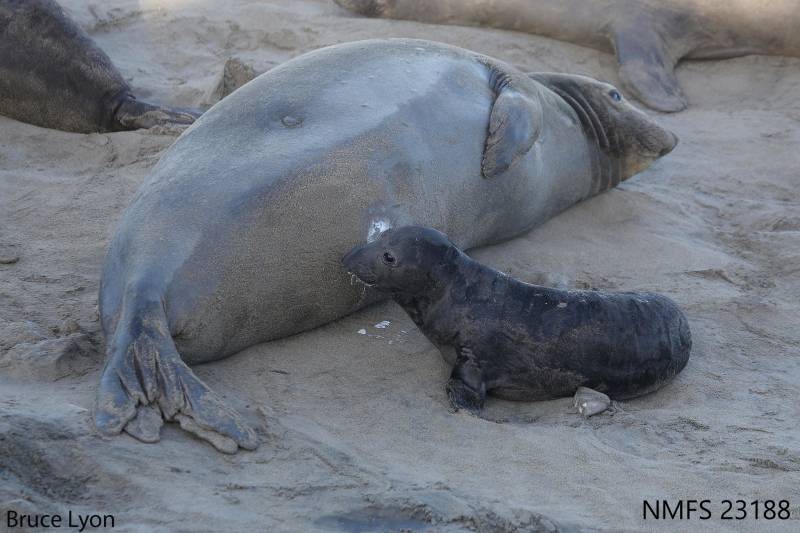“That ability to hold your breath for a super long time opens up this other way of sleeping — to sleep underwater,” Kendall-Barr says.
This is key to avoiding predators lurking near the surface — visual hunters who rely on light to find food.
“White sharks, killer whales,” says Kendall-Barr. “When you’re feeding on something that has to breathe, a good place to hang out is by the surface.”
Sweet dreams in the twilight zone
Sleeping underwater is just one skill pups need to master as they embark on their first sea voyage. After elephant seal mothers give birth in winter, they feed their pups milk for about a month before returning to the ocean to hunt. The youngsters are left on their own, with about four to six weeks to prepare for their first sea voyage in the spring. Because the adult female seals leave immediately after weaning, they are not around to teach pups crucial life skills such as how to hunt, avoid predators and navigate.
“There’s no learning that goes on between mom and pup,” says Roxanne Beltran, who co-leads the UC Santa Cruz elephant seal research program with professor Dan Costa. “The mom basically gives the pup milk and then leaves on her trip — and leaves the pups on the beach.”
This means any relationship between moms’ and pups’ traits or abilities is likely genetic, says Beltran, who specializes in studying juvenile elephant seals by observing and tracking pups to understand why some survive while others don’t.
 This tiny elephant seal, birthed at about 120 pounds, must gain enough milk fat to survive for four to six weeks on the beach after the mothers head back out to sea. (Dan Costa, UC Santa Cruz/Roxanne Beltran lab, permit number NMFS 23188)
This tiny elephant seal, birthed at about 120 pounds, must gain enough milk fat to survive for four to six weeks on the beach after the mothers head back out to sea. (Dan Costa, UC Santa Cruz/Roxanne Beltran lab, permit number NMFS 23188)
Pups already weigh about 120 pounds at birth, and by the time they’re done feeding on milk they’re about 300 pounds. Elephant seals feed on deep sea prey such as lantern fish and squid, which can’t be accessed from the beach. This means pups are fasting for as long as they remain on land. They rely on their milk fat to keep them alive while they grow and gain muscle, building up the strength they will need for their first trip out to hunt and migrate.
The first sea voyage is a harrowing ordeal. Pups learn on the go, practicing the diving skills they need both to sleep safely and hunt for food. Once they’re alone out in the open ocean, there is no safety in numbers and no kelp forests to hide in. Instead, seals must be strategic and rely on the cover of darkness by being active at night or by diving deep down where very little sunlight can reach. This part of the ocean, at depths between 200 and 1000 meters, is known as the twilight zone.
Pups start out diving to about 300 meters while holding their breath for about 10 minutes, and then work up to diving 600-700 meters and holding their breath for more than 20 minutes.
To study how elephant seals sleep, Kendall-Barr attaches electrode trackers to their heads. She found that seals sleep as they dive down in a slow spiral — drifting deeper and deeper, losing control of their bodies as their brains enter REM sleep.
These spiral naps last only 5 to 20 minutes, spread out between hunting dives. Comparing Kendall-Barr’s tracking data to years of general seal tracking data, researchers found that the seals are sleeping in this twilight zone, hundreds of meters under the surface.
Fear and food in the open ocean
Even if pups master their diving skills, the long-distance migrations necessary to find enough food are brutal. Twice a year, adult elephant seals migrate up to the Aleutian Islands of Alaska or halfway to Japan in the Northern Pacific. Between these migrations, they return to Año Nuevo’s beaches to breed and molt.
Many pups don’t survive their first voyages, which are shorter than those undertaken by adult seals. On top of learning to dive well enough to sleep underwater and hunt enough food to sustain themselves, pups also must learn how to avoid predators. Beltran has been tracking pups since 2018, and on average only half of the seals being tracked make it back to the beach where they were born. Adult elephant seals can live to be as old as 25, but the high mortality rate of pups hinders the species’ ability to maintain their population.
Beltran hopes to learn which factor is behind most first-voyage deaths — starvation or predation.
“I suspect that it is more likely predation than starvation,” says Beltran. “The only way to find out is to put trackers on them and to see where and when the seals go offline.”
The trackers measure the distance traveled and amount of time spent hunting prey on dives during the trip — like a Fitbit for seals. If the data shows plenty of hunting dives before going offline, chances are the seal got eaten by a predator. But if the trackers show little hunting before going offline, starvation is the more likely culprit.
Studying young elephant seals and how they develop these skills could provide insights into other marine mammal species that are much harder to study, such as whales, fur seals and sea lions.
“If we can figure out what’s constraining the juveniles, we can figure out what we need to protect — and that has a lot of implications for the conservation and management of marine mammals more broadly,” says Beltran.
Now, this spring’s pups are out on their own, using their hard-earned breath-holding skills as they avoid predators, dive for tasty nibbles and dream under the waves.


















